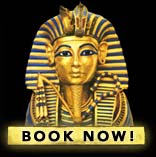Introduction to the exhibition and education kits
Imagine entering the tomb of Tutankhamun, as Howard Carter did in November, 1922, and seeing the 'wonderful things' it contained for the first time. This exhibition provides the opportunity to come closer to that experience, and explore the figures that guided ancient Egypt more than 3,000 years ago. The exhibition will display more than 130 extraordinary artefacts from the tomb of Tutankhamun, including his royal diadem and one of the four gold and precious stone inlaid canopic coffinettes that contained his mummified internal organs. Teachers and students with an interest in ancient Egypt will not be disappointed.
Tutankhamun and the Golden Age of the Pharaohs also provides the opportunity to view results from the latest scientific testing conducted on Tutankhamun's mummy and to discover what it is telling researchers about his life and death. Some questions have been answered while others remain unresolved and are still under investigation.
A rich variety of learning resources and web links are available on this website to extend this learning in the classroom before, during and after a visit to the exhibition. Using inquiry learning and cross disciplinary approaches, students can probe more deeply into the ancient dynasties of Egypt by responding to the essential question: 'How do we know what life was like in the time of Tutankhamun?' Students at all year levels can employ the creative arts and multi-modal texts to present their responses to this fascinating question.
The following education resources are now available on-line, with curriculum links for each state:
Middle Years Geography Kit
Middle Years Ancient History Kit
Senior Ancient History Education Kit
Senior Secondary English Kit
Language and Communication (ESL students)
Teachers can select a range of activities from different education kits to suit the specific needs of their learners.
Use the Tutankhamun Education Kit: Exhibition Overview to whet your students' appetite before their visit to the exhibition.
Book a group in to see the exhibition and receive a complimentary slide show of 15 significant objects to use in the classroom.
Visit Melbourne Museum website to access professional development opportunities.


















